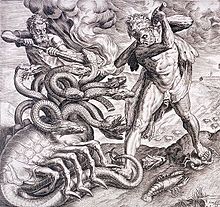Lernaean Hydra
In Greek mythology, the Lernaean Hydra (Λερναῖα Ὕδρα / Lernaīa Hýdra) was an ancient and ruthless chthonic aquatic monster in the form of a multi-headed serpent (whose number of heads ranges from three, five, seven or nine to one hundred, and even ten thousand depending on the source) and poisonous breath that Hercules killed in the second of his twelve labors. The Hydra had the virtue of regenerating two heads for each one that it lost or was amputated, and its lair was the lake of Lerna in the Gulf of Argolis (near Nauplia), although archaeologists have confirmed that this sacred place even predates the Mycenaean city of Argos, since Lerna was the place of the myth of the Danaides. Under its waters there was an entrance to the Underworld that the Hydra guarded.
The Hydra was the daughter of Typhon and Echidna and in some traditions was the mother of Chimera. She was raised by Hera under a plane tree near the Ammone spring in Lerna. It was said that she was the sister of the Nemean lion and that for this reason she sought revenge for his death at the hands of Hercules. This is why it was said that she had been chosen as a job for Hercules, so that he would die. [citation needed ]
The Hydra had many parallels in the Religions of the ancient Middle East. In particular, Sumerian, Babylonian, and Assyrian mythology celebrated the actions of war and the hunter-god Ninurta, who was credited by the Angrim with killing eleven monsters on an expedition into the mountains, including a seven-headed serpent (possibly identical to Mushmahhu).) and Bashmu, whose constellation (despite having only one head) was later associated by the Greeks with the Hydra. The constellation is also sometimes associated in Babylonian contexts with Marduk's dragon, the Mushhushshu.
Death at the hands of Heracles (Hercules)
After arriving at the swamp near Lake Lerna, Heracles and his nephew Yolao began fishing for bass in the pool of reeds, they covered their mouths and noses with a cloth to protect themselves from the poisonous breath of the Hydra. Heracles shot flaming arrows into the monster's shelter (Amimone's source) to force it out. He then confronted her with her sword and began to cut off the nine heads that he had from her. But every time he cut one, another was reborn in the same place stronger than the previous one. His nephew helped him by burning the neck of the severed head so that another would not be reborn. In the end, the Hydra died headless and Heracles dipped the tips of his arrows with the Hydra's blood so that they would be deadly to those he wounded (including Nessus).
The details of the confrontation are explained by Apollodorus: Realizing that he could not defeat the Hydra in this way, Heracles asked his nephew for help. He had the idea (possibly inspired by Athena) of using burning cloth to burn the stump of the neck after each decapitation, cauterizing the wound and thus preventing the two new heads from sprouting. Heracles cut off all the heads and Yolaus burned the necks open, thus killing the Hydra. Heracles then took the only immortal head from him and buried it under a great rock on the sacred path between Lerna and Eleus, dipping his arrows in the poisonous blood of the Hydra and thus completing his second labor.
In an alternate version, Hera sent a crab to bite at Heracles' feet and get in the way, hoping to cause his death. However, Heracles crushed the crustacean and continued to fight the Hydra. Therefore, the queen of Olympus put the crab in the starry skies as the constellation Cancer.
When Eurystheus, the king who assigned the tasks to Heracles, learned that it had been his nephew who had given him the torch, he declared that he had not completed the work alone and therefore did not count towards the total of ten tasks that he was given. they had assigned. This mythic element is an ambiguous attempt to resolve the conflict between the ten older works and the twelve more recent ones.
Artistic representations
- The Spanish painter Francisco de Zurbarán made ten canvases on the labors of Hercules, one of them being the death of the Hydra of Lerna at the hands of Hercules, which is in the Prado Museum.
- Romanesque capitals in the Church of Santa María de Bareyo (Cantabria)
- Movie Jason and the Argonauts (1963), directed by Don Chaffey
- Movie Hercules, Disney (1997)
- Percy Jackson Book: The Sea of Monsters
- Percy Jackson book: The Mark of Athena
- Percy Jackson Movie: Percy Jackson and the Lightning Thief
- Movie Hydra (2009)
- The video game God of War (2005)
- The video game Dark Souls (2011)
Constellation
Mythographers say that the Lernaean Hydra and the crab were placed in the sky after Heracles killed them. Hera put the crab in the Zodiac to follow the Lion, creating the constellation Cancer. When the sun is in the sign of Cancer, when the boreal summer and southern winter officially begin, the constellation Hydra has their heads close.
Contenido relacionado
Uranus (mythology)
Iapetus
Acamante



